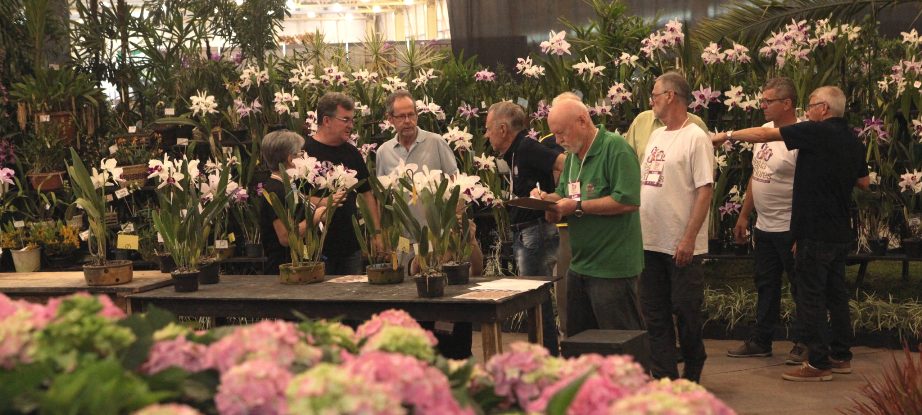
Judging the purpuratas at the 80th annual Festa das Flores, Joinville, Santa Catarina, Brazil, November, 2018
May-June 2020 with updates
We've been working on this blog entry off and on while waiting for the pandemic to end. We're looking forward to new material and new inspirations when we can get back to club meetings, sales, and shows. It's the interaction with live orchid enthusiasts and their plants that makes this blog possible.

Cattleya purpurata, Brazilian Style
Most of our members are familiar with with way orchids are labeled for sales and shows: genus (capitalized, in italics), species (not capitalized, in italics) or hybrid name (capitalized, not in italics), and cultivar name (capitalized, in single quotes). Occasionally we run into something a little different, such as a taxonomic subspecies or varietal name (not capitalized, in italics), or a horticultural form name (generally in italics, like a subspecies name). This system comes from a long history of attempts to make orchid names as clear (or precise? — these are not always compatible goals!) as possible, led by the Royal Horticultural Society. There have been quite a few changes along the way, and situations continue to arise where the rules don't seem to apply very well.
Meanwhile, the grand old orchids from the south of Brazil, in cultivation in Brazil since at least the 1820's, generated a local naming tradition that continues today, a mixture of Latin and Portuguese names and a different way of approaching the problem of names in some highly variable species. We encounter this problem most often with Cattleya (formerly Laelia and briefly Sophronitis, with recent suggested generic names Hadrolaelia and Brasilaelia) purpurata.
A plant from our 2019 auction recently came into bloom. The label says L. purpurata aco Clito. What does that mean? Another plant, a division of one of Fred Clarke's stock plants, says L. purpurata var. Werkhauserii 'Blue Monday' AM/AOS. We think we know what that means, but do we really? We decided to find out.
Cattleya purpurata comes in dozens or maybe hundreds of different shades and color patterns, from white to rose to purple to a peculiar shade called "cinza-chumba" or "cor ardósia", which translates to lead gray or slate-colored. How many of these have you seen? The purpuratas used to show up frequently at our meetings in the Whaley Park Community Center, back in the days when we could meet in person. They will show up again when we can resume our meetings. In the meantime, they light up our home orchid gardens. We hope you will share your pictures with us, either here or on Facebook!
During the 20th Century, there seems to have been a long tradition in Brazil such that status in the orchid world depended on possessing the very best varieties of Laelia purpurata, and sharing them with almost no one. Plants were seldom sold, and when they were, they fetched fabulous prices. Even when mericloning became possible, we understand most collectors of L. purpurata chose to keep their prized plants to themselves. We even discovered accounts of the judging system used at local shows, which required that all of the purpuratas that were displayed must have originated in the wild — thus eliminating from competition all seedlings and hybrids! There are tales of frustrated growers transporting their seedlings to some secret place in the forest and mounting them on trees, so that they would grow "in the wild" until they had the right amount of moss and lichen growing around the roots, so that they could then be "collected", brought back into captivity, and exhibited at the next show. At the same time, the supply of purpuratas growing in the wild must have dwindled to practically nothing. It is virtually certain that a great many notable varieties have never been seen outside of Brazil.
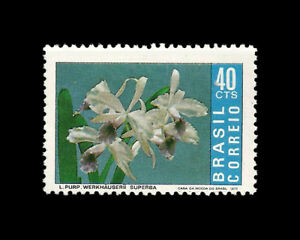
Brazilian postage stamp, 1971, featuring Laelia purpurata werkhauserii superba
Cattleya purpurata, under various names, is the official flower of the state of Santa Catarina and of various municipalities and organizations. It is also the star of the show at the annual Festa das Flores in Joinville, Santa Catarina, held in November of each year — the 2019 show was the 81st! We found some pictures that will give an idea of how seriously this "Queen of the Flowers" is regarded in Santa Catarina. The festival itself has grown to include an elaborate beauty pageant, garden shows, food, music, shopping, and all sorts of other entertainments. In some recent years, AOS judges have been invited to the Festa and have made a number of awards — we include some of the awards photos below.
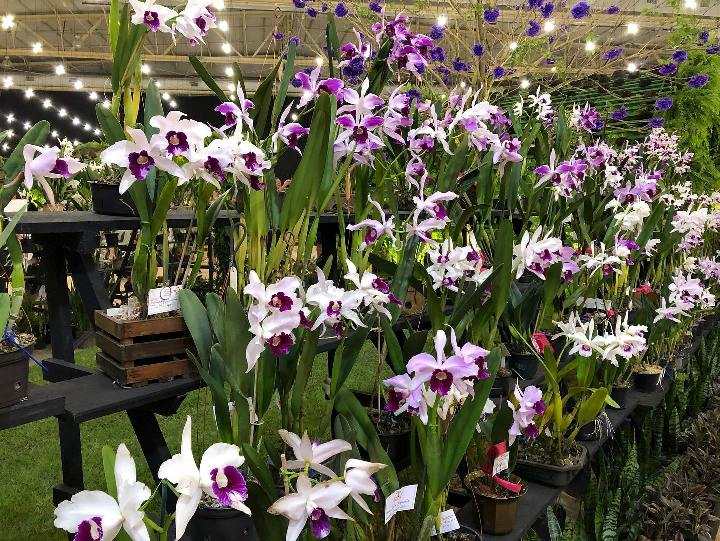
Festa das Flores, 2019
The Festa das Flores would never have lasted so long nor grown to such an extent, were it not for the astonishing array of colors of the purpurata flowers. However, in order to talk about things, they need names. There have been many attempts, both in Brazil and in the English-speaking orchid world, to agree on a set of names that can be applied intelligently to the purpuratas. In the European tradition, some varietal names were used, such as werkhauserii, based on one of the "slate-colored" plants (today we would usually call it a "blue" orchid) that was collected or obtained by Werkhauser. Unfortunately, Werkhauser himself seems to have made the varietal name less meaningful by applying it also to another "blue" purpurata. As a taxonomic variety, implying the existence of a distinct natural population characterized by the peculiar slate-blue color, werkhauserii has turned out to be in reality, as far as anyone seems to know, just a color form, having no taxonomic significance in the modern sense. Other, descriptive Latin "form" names have been applied, such as coeruleus or caeruleus (coeruleus is the older spelling in Latin, gradually replaced in the time of the Roman Republic; both are considered correct in botanical names), alba, semi-alba, rosea, carnea, and so forth. These are generally understood as descriptive words only, without the implication that they represent a distinct population that occurs in nature (although it is always possible that such a population could exist or had existed in the past, somewhere!).
But in Brazil, perhaps because there were so many colors and patterns of colors among the purpuratas, a sort of hybrid system has developed, a combination of Latin adjectives, Portuguese adjectives, and Latinized personal or place names, along with what appear to be unmarked cultivar names (i.e., names applying to an individual plant and its divisions or clones).
Let's see how it's done! We found several good summaries on the internet, the most complete in Portuguese. One that has the advantage that the photographs and the descriptions (2016 ?) were all compiled by the man who also grew and flowered all of the plants was prepared by Jose Carlos Budny, on the web site of the organization Orquídeas Nativas de Santa Catarina, based in Florianópolis, Santa Catarina, Brazil. This site uses the name Brasilaelia purpurata, based on a taxonomic proposal published in 2006 by Marcos Antonio Campacci and colleagues. Since then, a DNA study of the Cattleya alliance was undertaken by Cássio van den Berg, resulting in the conclusion that the Brazilian Laelias are no more distant genetically from the traditional Cattleyas than they are from each other, and that, therefore, the Brazilian Laelias belong in the genus Cattleya — this conclusion has been accepted by RHS and AOS, but it is always possible that future studies will require splitting the genus Cattleya, and if that comes about, we may end up back at Brasilaelia. (Note that this taxonomic procedure includes an assumption about "fairness" or "symmetry of nature", such that the dividing lines between genera should be placed so that the genera are more or less equally distant from each other by whatever measure is currently in fashion for distinguishing among plants. If we decide split out the Brasolaelias, so the argument goes, then based on symmetry or fairness, we will also have to split out a couple other groups. But, fellow orchidists, don't we all know that life itself is not fair, let alone symmetrical? We are dubious of this trend in taxonomy.)
Another very interesting source, and especially useful for Southern California growers, is a summary of a lecture by Amy Chung Jacobson, AOS Judge, for the Desert Valley Orchid Society, Phoenix, Arizona, on May 19, 2016, posted by "estación seca", a member of that society, on orchidboard.com, May 22, 2016. Amy notes that the classification used in Brazil applies to "color forms", and that the color forms do not breed true, the seedlings often do not resemble the parents. This observation is important; it tells us that the named "forms" are not distinct botanical varieties with a common genetic background, but rather, groups of plants defined only by the color and pattern of their flowers. A seedling of a plant labeled werkhauseri will very likely not be recognized as a true werkhauseri in Brazil. This fact leads to a suggestion for a consistent and possibly intelligible approach to naming these plants, which we will discuss in a later blog.
Cattleya Purpurata Color Forms
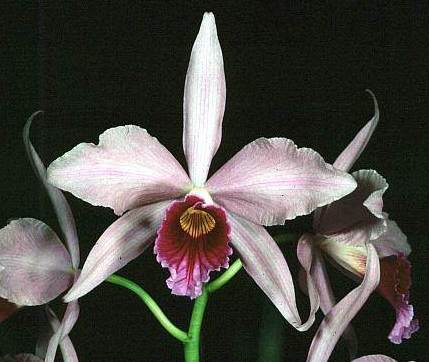
© 1994 AOS
C. purpurata tipo 'Tipo' AM/AOS exhibited by Peter Baxter June 13, 1994 at Los Angeles
"tipo" — the "typical" form, lip purple with striped throat, the sepals and petals pale rose to nearly white.
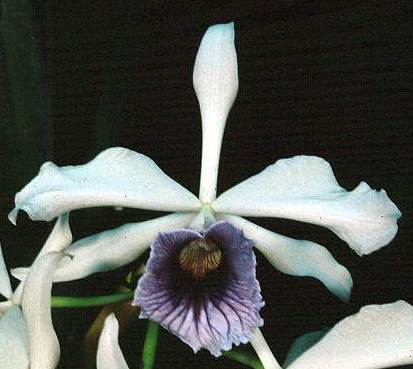
© 1988 AOS
C. purpurata werkhauserii (=ardósia?) 'Blue Swan' HCC/AOS exhibited by Fred Stewart Orchids May 9, 1988 at San Gabriel. The color seems far too purple for a true werkhaeuseri (we're looking for extreme ash-gray), or even for the ardósia category. Perhaps this plant would fit better in the Roxo-violeta (aka Aço) category.
"ardósia" — color ash-gray, "typical of the rock called slate" ("colorido cinza-chumbo típico da rocha denominada ardósia"), the lip with or without distinct veins, and the throat white or yellowish with dark stripes. The werkhauserii plants might belong here, but perhaps better and more traditionally as a separate group.

What color is Brazilian slate? 95% of it comes from the state of Minas Gerais, and the normal color is a deep gray with subtle hints of green, blue, and purple. This is the "rocha denominada ardósia" that the Ardósia group of C. purpurata forms are supposed to resemble.
The story of the werkhauserii plants, a story that seems to have been circulating in Brazil for decades, is perhaps not unusual for a purpurata, apart from the rarity of the color. Two plants with this odd "slate gray" color were discovered around 1902-1904 by Karl Werkhäuser near Porto Alegre. One of them had exceptional form and came to be known as superba, the other had the same color but poorer form. After Karl died in 1914, the plants went to his children. His daughter ended up with superba, which was almost never seen and which was secured, it is said, by seven locks. It was not until 1954 that she was induced to sell a 5-bulb division of superba for a very large sum that, as far as we know, was never disclosed. But it has also been suggested that a number of other wild-collected plants in the same color range were also dubbed werkhauserii, and it does not seem to be known if any of the superba plants known today are actually divisions of the original plant. The name has also been spelled werckhauserii, werckhauseri, and werkhauseri, also werkhaeuserii and werkhaeuseri. The latter is the more "correct" one as a Latinized name, but the older werkhauserii spelling is the one that is most often used in Brazil.
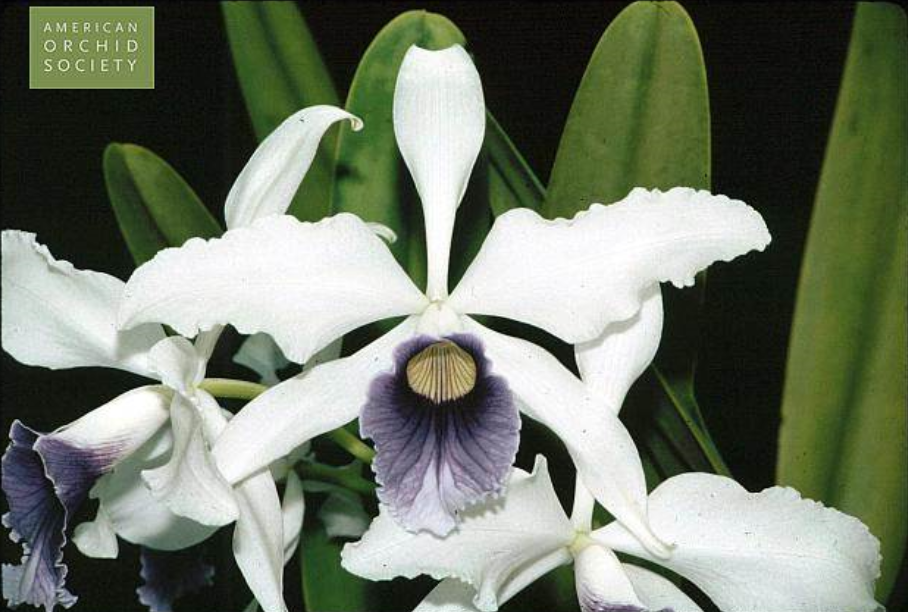
© 2000 Rhonda Peters
C. purpurata (Werkhauseri) 'Kathleen' AM/AOS exhibited by William Rogerson June 3, 2000 at Glencoe, Illinois. If the color is accurate — and it's notoriously difficult to capture these hues on film — this would seem to fall within the description of the true werkhaeuseri.
In 2018, the Orchid Committee of the Royal Horticultural Society added to the discussion of these plants, on the occasion of setting up a show and needing to verify plant labels. In Orchid Review, supplement to volume 126, containing orchid hybrid registrations for July through September, 2018, the "Registrar's Notes" explain how they arrived at the label Cattleya purpurata 'Werkhaeuseri', thus making the plant a cultivar rather than a form, variety, or some other grouping derived from multiple wild-collected plants. Significantly, after they located what are believed to be the oldest references to these plants, it was determined that the spelling werkhaeuserii was the original "published" spelling (Ferdinand J. Krackowizer, Monographia da Laelia purpurata, suas variedades et seus hibridos(1950) and, no author mentioned, "Pequeno subsidio para a historia da purpurata Werkhaeuserii", in Orquidea (Brazil) 12(3):84-88 (May-June 1950), and apparently referencing correspondence by Werkhäuser himself in 1908). They deterimined that no valid description of werkhaeuseri as a botanical variety had ever been published, and they concluded that Werkhaeuseri, a "botanically invalid published name", can still appropriately be used as a cultivar, grex, or Group epithet. They suggest that Werkhaeuseri could be used as a Group name (recall that the origin story cited above says the name was applied to at least two wild plants, differing in the form of the flower, thus not properly fitting the definition of a cultivar).
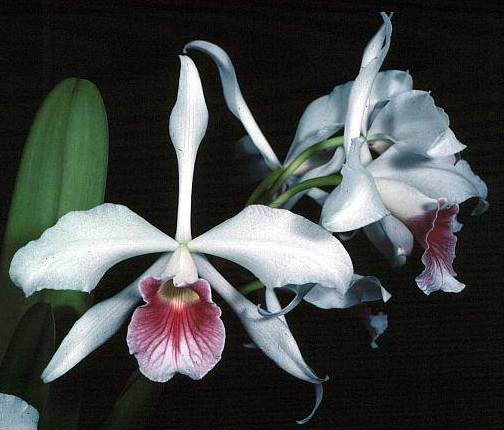
© 1979 AOS
L. purpurata cárnea 'Bion' HCC/AOS, exhibited by John Hanes May 21, 1979 at Long Beach
"cárnea" — lip color described as "color of raw meat", or raspberry, or strawberry, with more or less prominent veins, throat white or yellowish.
"Canhaduba" — named for the locality where this form was first discovered, in the municipality of Camboriú, lip pale "lilac-raspberry".
"roxo-violeta" — lip purple-violet, with bluish tinges and grading sometimes to nearly black, the sepals and petals white or very pale bluish. This variety is known in some regions as "aço" ("steel", referring to the purplish sheen that forms by oxidation on the surface of some kinds of steel). The "variety" schusteriana, which some sources say is simply a single plant from a private collection, belongs here.
"roxo-bispo" — lip has the color of the "purple" (closer to magenta) cassock worn by Roman Catholic bishops (the name means "bishop purple" — one version says that it was the color of the vestments used by a bishop at a church in Porto Alegre). In Santa Catarina these varieties are sometimes called "santo bispo".
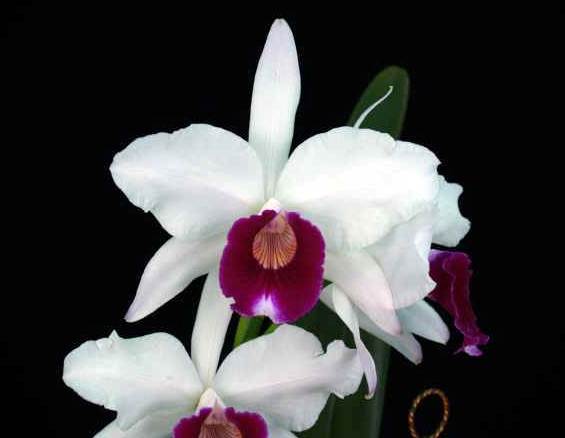
© 2006 Kenneth Jacobsen
C. purpurata semi-alba 'Nessler' AM/AOS, exhibited by Rodrigo Nessler November 11, 2006 at Joinville
"semi-alba" — sepals and petals entirely white, the lip deep red-purple similar to the "tipo" form.
"suave" — lip very pale rose, sepals and petals white or nearly so.
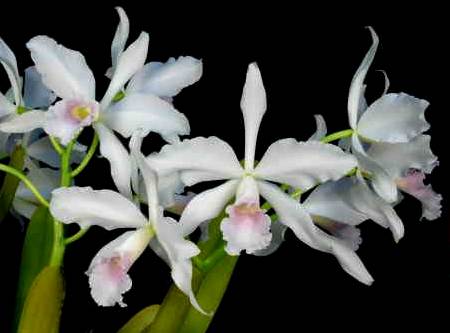
© 2007 Loren Batchman
C. purpurata russelliana (delicata) 'Sunset Valley Orchids' HCC/AOS, exhibited June 25, 2007 by Fred Clarke at Long Beach
"russelliana" — The lip is rose pink with deeper shading. This variety has been the subject of some taxonomic description. It seems to include some Brazilian varieties labeled "Delicata", "Graciana", and "Gracicata".
"vinicolor" — lip the color of red wine, a brighter and more intense color than the "tipo" form.
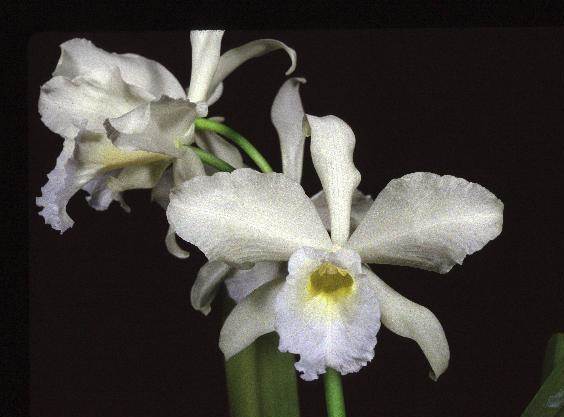
© 1993 AOS
C. purpurata alba 'Driven Snow' HCC/AOS, exhibited by Jerry Rehfield March 24, 1993 at Long Beach
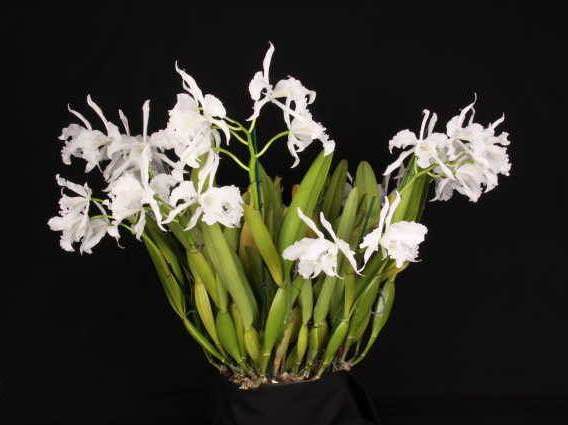
© 2010 Arthur Pinkers
C. purpurata alba 'Espie Quinn' CCM/AOS, exhibited by Espie Quinn June 28, 2010 at Long Beach.
"alba" — totally white, apart from pale yellowish in the throat.
"concolor" — the lip and the sepals and petals are more or less the same color (any color, but excluding the alba forms!), although the lip will usually be somewhat darker than the rest of the flower.
"rubra" — all parts of the flower are strongly colored rose-purple, but see also "flammea" and "sanguinea" forms.
"sanginea" — all parts of the flower are a deeper red-purple, and the throat is usually considerably darker than in some other forms.
"atropurpurea" — lip is deep purple, and there are strong purple markings or shadings on the petals and sepals. The throat is usually very dark.
Forms distinguished by the pattern of coloration of the lip:
"anellata" — the pigment on the lip is limited to the edge of the throat, and forms a thin ring that encircles the throat.
"argolão" — there is a much broader and less circular ring of pigment around the throat, extending no more than 1/3 the width of the lip.
"aurea" — the throat is stronly yellow or gold in color, and the red or purple veins in the throat do not meet up with the purple of the lip.
"madayana" — similar to russelliana, but in the original form of madayana, there were no lines in the pale yellow throat.
"marginata" — there is a thin white border around the entire lip.
"multiforme" — a catch-all category for variants of the normal lip coloration that can't be classified into any single category.
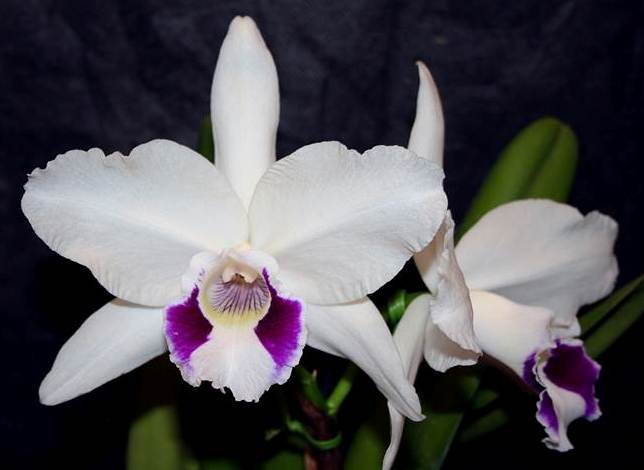
© 2014 Alan Koch
C. purpurata oculata 'Preciosa' AM/AOS, exhibited by Henrique do Nascimiento November 13, 2014 at Joinville
"oculata" — the lip is purple with a big, pure white area in the middle running all the way into the bright yellow throat.
"reginae" — the lip has a thin pale edge on the sides, and the midlobe of the lip is mostly white, so that the pigment in the lip forms a thick ring surrounding the white throat.
"schroederae" — the end of the lip white, with stripes? We couldn't find a detailed description.
Forms distinguished by the pattern of coloration on the petals:
"flammea" — intense colors on the petals, with stripes extending along their length.
"striata" — less intense colors on the petals, and the stripes not as extensive.
"venosa" — intense colors on the petals, but with a lot of white still showing, especially at the base and margins of the petals.
If you haven't seen most of these varieties in person, don't be surprised! A glance at the AOS awards database on the AOS web site shows that relatively few of these have had their close-ups, and the majority of those were at shows in Brazil.
Don't be surprised, either, if you find purpuratas that don't fit neatly into these categories. One Brazilian orchidist describes the classification as "chaos", and many have expressed the opinion that there will always be plants that are intermediate between two or more categories, as a result of hybridization, and also from the fact that the orchids collected from the wild never read the rules.
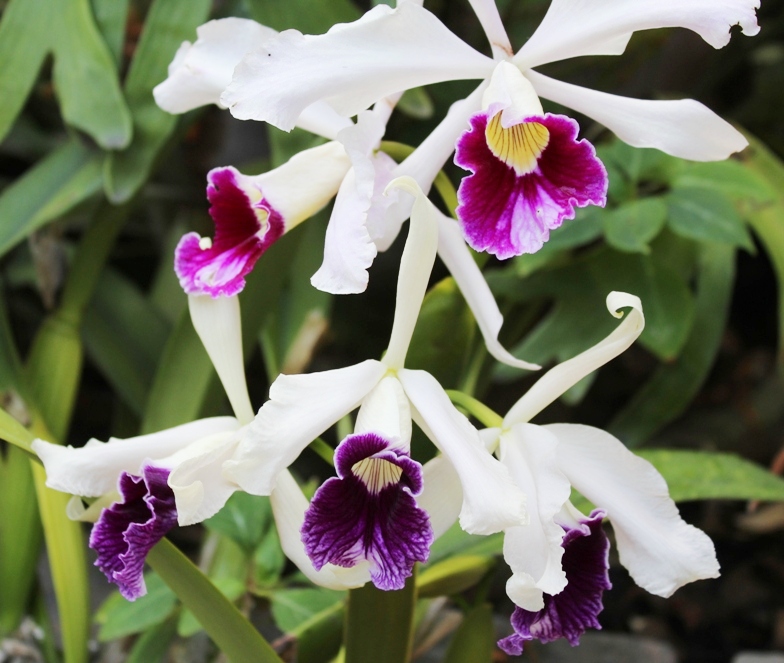
C. purpurata aço 'Clito' (top) and C. purpurata "werkauserii" 'Blue Monday' in bloom at the same time.
So what to do with L. purpurata aço Clito? We should probably treat Clito as a cultivar name (although we have no way of knowing whether all the plants so labeled actually are divisions or clones of the same original plant) and place it in single quotes: 'Clito'. We might also relabel it as variety roxo-violeta, as suggested above.
For 'Blue Monday', we're less sure. This cultivar was exhibited by SCOS members Herb and Rita Crothers in 1977. The AM award calls it variety werkhauserii, but the color is far brighter than the ideal "slate" shade. Still, it is distinctly "bluer" than our 'Clito', and it has a larger, fuller lip. In fact, we know next to nothing about the origin of this plant, apart from who exhibited it. Even if it were a seedling of the true, original "Werkhauserii superba" plant, it does not fit the color criteria. Perhaps the best approach is to dispense with the uncertain (and botanically invalid) variety designation altogether, and call it C. purpurata 'Blue Monday', thus allowing it to stand on its own merits.
What's the bottom line here? It seems to us we should avoid bestowing varietal names on plants whose provenance is not known to us. We should maintain the Brazilian form names that we find on plant labels at sales and shows, provided they match reasonably well with the colors and patterns of the flowers. We should note any discrepancies that might suggest a plant has been mislabeled, but keep the original designation as well, since it might eventually help us track down the actual history of the plant and lead us to its original name.
Above all, we should all be growing at least a few purpuratas, because they adapt so well to our local growing conditions.
Bonus Corner! ... SECOND-HAND ORCHID advice!
Here's what "estación seca" reports in his notes from Amy Chung Jacobsen's lecture (see above) about how she grows Cattleya purpurata in the San Francisco Bay area. Southern California hobbyists should find this especially helpful, judging from the reported temperature ranges.
"Growing Laelia purpurata. Laelia purpurata is a vigorous, fast-growing plant when happy. Because of its vertical growth habit and short rhizomes, it is easier to accommodate L. purpurata in a collection than many other large Cattleyas. The commonest growth errors are not giving enough light, water and fertilizer.
"Santa Catarina State has an annual temperature range between 50-80 F / 10-27C. (But L. purpurata does fine outside this range!) It averages 61" / 155 centimeters of rain per year. The winter is at the cooler end of the range, and is drier. The lowest rainfall is in June, mid-winter in the southern hemisphere, averaging 3" / 762mm during that month. Summer brings drenching rain almost every day. The plants are never dry for long in habitat.
"Amy has found they do well with daytime temperatures between 55 F / 13C in winter and 95 F / 35C in summer, with occasional summer excursions to 115 F / 46C for many hours during the day. Summer nights always cool down where she grows, into the 60's F / 15-20C.
"They grow well with routine winter nightly lows of 35-55 F / 2-13C. Her plants have experienced 24 F / -4.5C in winter for 5 nights in a row with no damage. Laelia purpurata is more cold-hardy than are Cymbidium hybrids. Amy has noticed Portuguese-speaking orchids are very cold hardy, while Spanish-speaking orchids are not. She suggested we try them outside in Phoenix on a patio, with some shade from the hot sun, and perhaps other plants around to increase humidity.
"They are high-light plants. She grows in an unshaded greenhouse. Ken grows his hybrid Cymbidiums at up to 120 F / 49C most every day in the summer, and 100% humidity, in Los Altos, with no shade on the greenhouse. She suggested here in Phoenix we use 50%-70% Aluminet during the hottest months, and no shade during cooler months.
"Laelia purpurata prefers high humidity at all times, but accepts much less without complaining. During her hot spells of 115 F / 46C, her relative humidity is around 30%.
"They need drenching water during the summer, with less water in the winter. They should not be dry for very long at any time of the year. She provides fertilization with almost every watering during the summer, using 64 PPM nitrogen. She gives less during the winter, but still fertilizes. She uses an MSU blend, or Miracle-Gro, if she gets it on sale at Costco at the end of the season. She and Ken have so many plants they fertilize with an injector system.
"Like all Cattleya types, they need good root aeration. They are not particular about medium. They do well in Orchiata, Kiwi Bark, perlite, charcoal, plain bark — whatever is well-aerated. She uses Orchiata because she and Ken go through so much of it, and live near a supplier, so they have pallets delivered with no additional charge. She doesn't think a long-lived medium is an advantage; they grow so fast, they usually need repotting every 2 years. She recommended the largest chunks for mature plants, and the next size down for smaller mature plants. She uses straight bark, rather than mixing it with perlite or LECA, because non-organic material cannot go into the garden waste bins for pickup where she lives.
"Don't divide Laelia purpurata if you can help it! It flowers much better, with more flowers per stem, when it's a large plant. Amy said she grows in 12" plastic bulb pans because it's hard for her to get larger bulb pans. She would use 16" pots if she could get them reasonably. She uses bulb pans because they're shallower than standard pots, so they dry out faster, and she can water and fertilize more often. She uses plastic because she's had greenhouse benches collapse under clay-potted L. purpurata.
"You don't need to repot when the 1st growth walks out of the pot. Such a growth will bloom just fine. But, repot when the 2nd growth out of the pot is forming. When you repot, remove all the old bark.
"Unlike many Cattleya species, L. purpurata makes roots twice yearly: March and September (northern hemisphere.) Wait to repot until new roots are growing. If you break the green tip of a new root, the root dies back to the rhizome. Older roots might branch. So, repot when new roots are short."